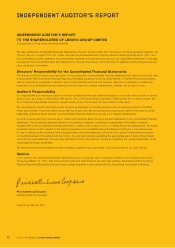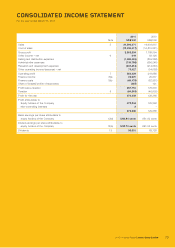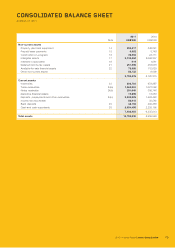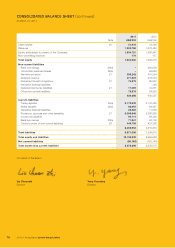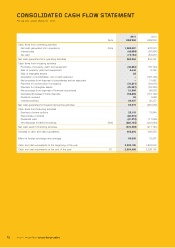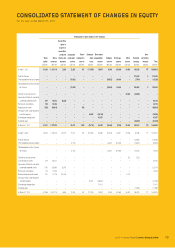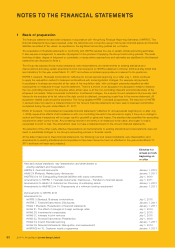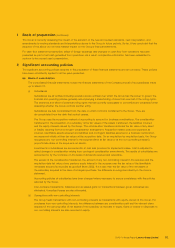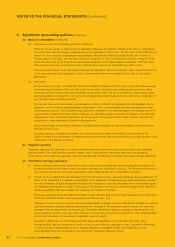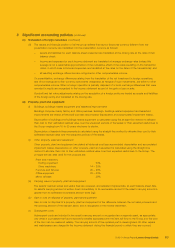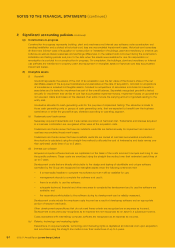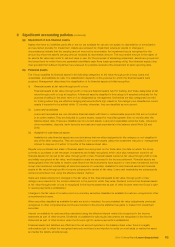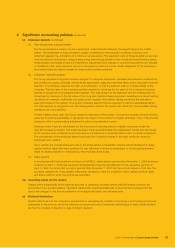Lenovo 2011 Annual Report Download - page 78
Download and view the complete annual report
Please find page 78 of the 2011 Lenovo annual report below. You can navigate through the pages in the report by either clicking on the pages listed below, or by using the keyword search tool below to find specific information within the annual report.
2010/11 Annual Report Lenovo Group Limited 81
1 Basis of preparation (continued)
The Group is currently assessing the impact of the adoption of the new and revised standards, new interpretation, and
amendments to existing standards and interpretations above to the Group in future periods. So far, it has concluded that the
adoption of the above do not have material impact on the Group’s financial statements.
For cash flow statement presentation, effect of foreign exchange rate changes on cash flow from operations has been
presented as part of net cash generated from operations. As a result, comparative information has been reclassified to
conform to the current year’s presentation.
2 Significant accounting policies
The significant accounting policies adopted in the preparation of these financial statements are set out below. These policies
have been consistently applied to all the years presented.
(a) Basis of consolidation
The consolidated financial statements include the financial statements of the Company and all of its subsidiaries made
up to March 31.
(i) Subsidiaries
Subsidiaries are all entities (including special purpose entities) over which the Group has the power to govern the
financial and operating policies generally accompanying a shareholding of more than one half of the voting rights.
The existence and effect of potential voting rights that are currently exercisable or convertible are considered when
assessing whether the Group controls another entity.
Subsidiaries are fully consolidated from the date on which control is transferred to the Group. They are
de-consolidated from the date that control ceases.
The Group uses the acquisition method of accounting to account for business combinations. The consideration
transferred for the acquisition of a subsidiary is the fair values of the assets transferred, the liabilities incurred
and the equity interests issued by the Group. The consideration transferred includes the fair value of any asset
or liability resulting from a contingent consideration arrangement. Acquisition-related costs are expensed as
incurred. Identifiable assets acquired and liabilities and contingent liabilities assumed in a business combination
are measured initially at their fair values at the acquisition date. On an acquisition-by-acquisition basis, the Group
recognizes any non-controlling interest in the acquiree either at fair value or at the non-controlling interest’s
proportionate share of the acquiree’s net assets.
Investments in subsidiaries are accounted for at cost less provision for impairment losses. Cost is adjusted to
reflect changes in consideration arising from contingent consideration amendments. The results of subsidiaries are
accounted for by the Company on the basis of dividends received and receivable.
The excess of the consideration transferred, the amount of any non-controlling interest in the acquiree and the
acquisition-date fair value of any previous equity interest in the acquiree over the fair value of the identifiable
net assets acquired is recorded as goodwill (Note 2(f)(i)). If it is less than the fair value of the net assets of
the subsidiary acquired in the case of a bargain purchase, the difference is recognized directly in the income
statement.
Accounting policies of subsidiaries have been changed where necessary to ensure consistency with the policies
adopted by the Group.
Inter-company transactions, balances and unrealized gains on transactions between group companies are
eliminated. Unrealized losses are also eliminated.
(ii) Transactions with non-controlling interests
The Group treats transactions with non-controlling interests as transactions with equity owners of the Group. For
purchases from non-controlling interests, the difference between any consideration paid and the relevant share
acquired of the carrying value of net assets of the subsidiary is recorded in equity. Gains or losses on disposals to
non-controlling interests are also recorded in equity.



